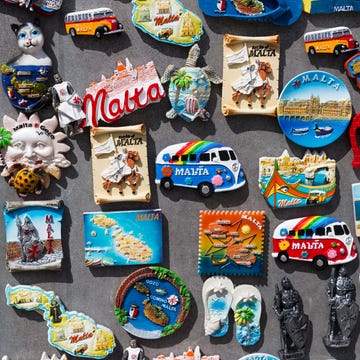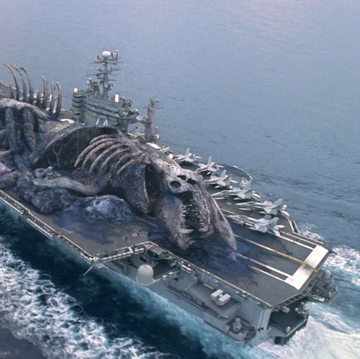Courtney Linder here, deputy editor at Popular Mechanics. I’m willing to bet you probably know at least one person who is obsessed with collecting dazzling gemstones and crystals. Some gather these colorful, often shiny stones for mere display, while others perceive the rocks as containing mystical healing properties. But is there any scientific proof that these crystals and stones have the capacity to heal our bodies and minds? Or are crystals truly just pretty objects that offer up some sort of placebo effect that can convince us something more magical is at play?
First, let’s consider the primary argument for crystals as healing conduits. In short, the belief is that certain stones can help guide healing energy into the body, while ushering out negative, disease-causing energy. This supposedly occurs through your body’s energy field, or chakra; the energy is variably referred to as “qi,” “prana,” or “universal energy,” according to Jonathan Jarry, a science communicator at McGill Office for Science & Society in Montréal.
Crystals are often incorporated into practices like reiki, a Japanese form of energy healing, and in specific crystal-healing practices like “crystal surgery,” wherein a practitioner uses crystals as tools for “operating” on the body’s energy field (don’t worry, it’s not an invasive practice—no scalpel required). In these treatments, practitioners attempt to “unblock” areas of our energy field that are “stuck.”
But it’s not so easy to measure whether such bodily energy exists in the first place, Jarry says. Scientists can study other forms of energy, like gravity or the energy contained in food, because we can see an apple fall from a tree, and we can zoom in on the process of glucose from an apple breaking down into adenosine triphosphate (ATP), which provides energy for our cells.
Still, scientists have tried. In the 1990s, Dr. Stephen Barrett—a now-retired psychiatrist who runs Quackwatch, an organization dedicated to health fraud and general quackery—designed an experiment to see if therapeutic touch (TT) practitioners could truly identify and manipulate our human energy field. In it, 21 practitioners with experience ranging from one to 27 years were tested under blind conditions to see if they could correctly determine which of their hands, the right or the left, an investigator was hovering their own hand over. Practitioners only identified the correct hand in 123 of 280 trials, or about 44 percent of the time, about the same odds as flipping a coin.
Now back to crystals. If there is no proof of a human energy field existing, how can crystals manipulate it?
✅ Stranger Than Fiction
- The Science of Bad Vibes: Can Some Places Really Hold Onto Negative Energy?
- The Eternal Quest for Aether, the Cosmic Stuff That Never Was
- Is It Possible to Measure the Human Soul?
“Crystals absorb energy from pressure and movement and convert it into an electronic frequency,” Jude Polack, founder and director of bewater, a company that sells crystal-infused water bottles, tells Healthline. “It’s this frequency, unique to each type of crystal, that users are relying on when working with crystals, and given that many pain and anxiety relief devices work on similar principles, we do believe they can help in these areas.”
In the 1880s, Pierre and Jacques Curie—two physicists who also were brothers—conducted a study and found that putting pressure on or changing the temperature of crystals could result in electricity. This is known as the piezoelectric effect, and it’s used in technologies like watches, wherein quartz crystals indeed exercise special time-keeping properties through vibrations at a certain frequency. The Curie brothers’ work suggests that crystals could have a minor effect on our body’s energy levels, but that does not automatically translate to healing powers.
“Just because an object possesses a specific type of energy does not mean that we humans can pick up on it with our body,” Jarry tells Popular Mechanics. “For example, magnetic energy is very real and measurable with the right equipment, but we humans don’t have, for example, magnetoreception the way that homing pigeons [do]. So, the fact that quartz crystals contain an energy that can be exploited via the piezoelectric effect does not imply that we humans should be able to pick up on it. The healing energy that is claimed to come with certain crystals is instead some poorly defined concept, which lends itself well to the placebo effect.”
Case in point: another study conducted in 2001 by British psychologist Christopher French challenged 80 volunteers to differentiate between real and fake crystals after holding them in their hands for five minutes and meditating. Six people felt nothing at all, and the rest reported feeling some energy, whether in the form of tingling in the body or an improved sense of wellbeing. Both groups, though—whether holding the fake crystals or the real ones—reported similar impressions, suggesting the placebo effect could be at play.
“When scientists conduct robust clinical trials, they want to strip the intervention of these placebo effects to figure out if it has a specific benefit,” Jarry explains. “Alternative medicine’s reputation benefits strongly from these non-specific placebo effects. Enough people will start to feel better after using crystals (because of regression to the mean, self-limiting illness, misremembering, etc.), and they will publicly testify to their improvement, giving the illusion that crystals work. What they don’t know is what would have happened had they not used the crystals.”
So, if you want to keep a hunk of amethyst at your desk to alleviate your grief, or a Tiger’s Eye stone to clear the mind, go ahead: they may not be manipulating a sacred energy field around your body to heal you, but they can certainly manipulate your mind.





